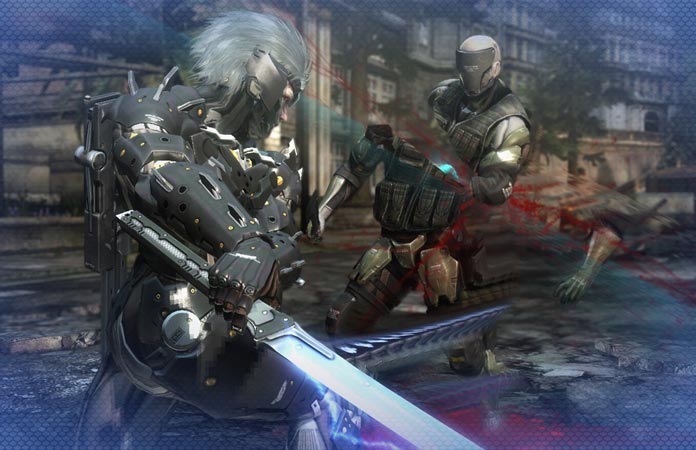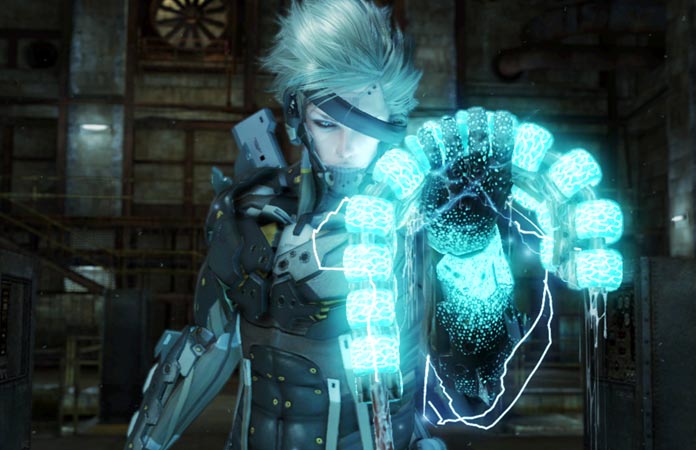Game Review: Metal Gear Rising: Revengeance
Published on March 13th, 2013 in: Current Faves, Game Reviews, Gaming |By Luke Shaw

Image from http://daxgamer.com/
If you sliced the code open, you’d realize that there is a singular philosophy running through Metal Gear Rising: Revengeance, and that the entire game is a slave to it. Every piece of extraneous flab has been cut off with reckless abandon. It is not so much Occam’s Razor as Raiden’s Razor, a shimmering blade, crackling with electricity, held at the player’s throat, paralyzing you, unblinking and sweaty-palmed whilst you’re gruffly asked one question over and over as the sweat runs down your neck and fizzles to nothing at the touch of the sword: “Cut or be cut, cut or be cut, cut or be cut . . .”
Platinum Games have a long history of producing high-octane action games like the arcade bombast of Vanquish and the current benchmark for all things over the top, Bayonetta, directed and produced by Capcom veterans such as Hideki Kamiya and Shinji Mikami. Now, teaming up with Konami and tasked with reinvigorating one of gaming’s most incorrectly maligned characters, Raiden, Revengeance sees Platinum not so much reinventing the wheel, as filing it down to a single, elegant edge.
Playing as the cyborg suit-equipped Raiden, the game begins with a bang as you and the African President are attacked by shady private military company Desperado Enforcement LLC, whose members include the katana-wielding future nemesis Jetstream Sam, and a mysterious bald giant with two huge machetes used as a pair of giant scissors. Within minutes of this opening, you are flung headlong into battle with a three-story Metal Gear that you casually throw over your shoulder before slicing it in two, before being disfigured by the aforementioned Sam. It’s OK, you can take a breath now; the prologue is over.
From here, Raiden is embroiled in conflict with Desperado and their schemes which play out like a typical Metal Gear storyline, with references to such esoteric subjects as child trafficking, the morality of cyborg implants, the evolution of AI, and a typical last-minute villain reveal. Fitted out in a state-of-the-art suit (with stylish heels, sharp finger extensions, cybernetic eye-patch, and entirely superfluous metal jaw) Raiden’s journey through this madcap plot is alarmingly straightforward and rattles along at a pace befitting an action title, whilst still finding time for irreverence in Codec asides. Raiden spends most of the cutscenes as a reversal of his introspective former self, instead brimming with pithy remarks and contemptuous sarcasm towards the game’s lyrical characters. After all, as per the game’s subtitle, all he is really out for is Revenge. Vengeance. Revengeance.
From such an absurd title stems a game of furious focus, as if its creators took inspiration from the forging of katanas in times gone by, by taking every layer involved and hammering it flat until every element was honed to such keenness that it was able to cut a blade of grass in two, or in the case of Revengeance, dice a man into 250 pieces without ever dulling. The core of the combat is much simpler than Bayonetta or Devil May Cry, with your sword being the weapon you will use 99 percent of the time.
Direct light attacks are located on one button, with broader reaching heavy attacks on another; combos are simple and almost endless save for a few finishing flourishes that become easy to memorize. Sub weapons such as rockets and grenades have their own menu, and late-game alternate weapons simply replace Raiden’s heavy attacks with their own unique palette. Primitive stealth mechanics also make an appearance, as does the series’ signature cardboard box, adding another way to thin out the ranks of cyborgs and combat mechs before the next inevitable adrenaline-fueled bout.
The focus on the sword being the main source of offense is reflected by the lack of a dodge or block function; to protect himself Raiden must parry by hitting attack and simultaneously pushing towards the direction the attack came from. Importantly, the parry can be used to interrupt of the vast majority of attack animations and, if timed perfectly, allows a vicious follow up to be performed. The addition of an unlockable dodge move is welcomed due to certain telegraphed attacks that will brutally crush Raiden’s parry, yet even this lightning fast sidestep is accompanied by a token sword swing, rightfully earning it its title of “Offensive Defense.”
With the parry function being buried so deep into his move set and its mapping onto the primary attack button, Raiden becomes a dervish of synthetic muscle and High Frequency blade. Every attack is a chance to defend yourself, and the game encourages you to never stop your attack, as each move allows seamless transition to the target to the left, or behind. Each encounter plays out at a speed somewhere on the edge of conscious thought, with each cut and parry a reaction rather than an informed decision, the only thing ever threatening to hamper the enjoyment being a slightly exuberant camera which is tameable through practice.

Image from http://www.officialplaystationmagazine.co.uk
The calm between these storms is Blade Mode, or the ability to slow down time so that Raiden may unleash a flurry of strikes so vicious that they leave the enemy in ribbons on the floor. To accentuate the non-stop pace of the game, health pickups trigger automatically, but they aren’t even the main source of energy. Within each enemy hides a tantalizing spinal column colored electric blue, highlighted on screen with a red square, and with enough finesse Raiden can extract these in Blade Mode and crush them in his hand, a thunderclap and roar of “Dead on!” accompanying the action and the replenishment of health. This technique, known as “Zandatsu” or “cut and take,” means that combat requires you to strike a frenetic balance between earning energy from blows to enable Raiden to top his life, and losing it as second later to an enemy onslaught; this is an equilibrium that is only reachable through a relentless and focused assault that will see you through the game’s many furious whirlwind skirmishes.
Despite a single run through of the game being around the six or seven hour mark, even less if and when you skip the cutscenes, Revengeance manages to cram in seven deliriously over the top and inventive boss encounters, from a smoke bomb-wielding ninja made of magnets to a shirtless approximation of Mayor Haggar, plus its fair share of blockbuster movie-shaming spectacle. Complete with a soundtrack that’s an enthusiastic adolescent mix of dubstep and power metal which ebbs and flows with the combat in a way that fits the game like a glove, it makes it a joy to play through multiple times.
Further enjoyment also comes through standalone VR missions and the masochistic ecstasy of cranking the difficulty up to fearsome levels that take great pleasure in dragging your face down along the asphalt until you find yourself in the calm of Raiden’s storm, and the tactile combat system allows you to get your revenge with stylish impunity. Like the sword he wields, Metal Gear Rising: Revengeance is a beautiful and deadly object, the result of a pure philosophy being fused with a Japanese penchant for excess. It is a tool that excels at one thing so perfectly, and with such vigor, it’s impossible to play without a smile as wide as canyon carved by the thunder god himself.
Time limit is exhausted. Please reload the CAPTCHA.